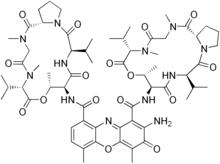 | |
 | |
| Clinical data | |
|---|---|
| Trade names | Cosmegen |
| Other names | Actinomycin D 2-Amino- 4,6-dimethyl- 3-oxo- 3H-phenoxazine- 1,9-dicarboxylic acid bis- [(5,12-diisopropyl- 9,13,16-trimethyl- 4,7,11,14,17-pentaoxo- hexadecahydro- 10-oxa- 3a,6,13,16-tetraaza- cyclopentacyclohexadecen- 8-yl)- amide] |
| AHFS/Drugs.com | Monograph |
| MedlinePlus | a682224 |
| Pregnancy category |
|
| Routes of administration | IV |
| ATC code | |
| Legal status | |
| Legal status | |
| Pharmacokinetic data | |
| Protein binding | 5% |
| Metabolism | hepatic |
| Elimination half-life | 36 hours |
| Excretion | Bile[1] |
| Identifiers | |
| |
| CAS Number | |
| PubChem CID | |
| DrugBank | |
| ChemSpider | |
| UNII | |
| KEGG | |
| ChEBI | |
| ChEMBL | |
| NIAID ChemDB | |
| CompTox Dashboard (EPA) | |
| ECHA InfoCard | 100.000.058 |
| Chemical and physical data | |
| Formula | C62H86N12O16 |
| Molar mass | 1255.438 g·mol−1 |
| 3D model (JSmol) | |
| |
| |
| | |
Dactinomycin, also known as actinomycin D, is a chemotherapy medication used to treat a number of types of cancer.[2] This includes Wilms tumor, rhabdomyosarcoma, Ewing's sarcoma, trophoblastic neoplasm, testicular cancer, and certain types of ovarian cancer.[2] It is given by injection into a vein.[2]
Most people develop side effects.[2] Common side effects include bone marrow suppression, vomiting, mouth ulcers, hair loss, liver problems, infections, and muscle pains.[2] Other serious side effects include future cancers, allergic reactions, and tissue death if extravasation occurs.[2] Use in pregnancy may harm the baby.[2] Dactinomycin is in the cytotoxic antibiotic family of medications.[3] It is believed to work by blocking the creation of RNA.[2]
Dactinomycin was approved for medical use in the United States in 1964.[2] It is on the 2023 World Health Organization's List of Essential Medicines.[4]
- ^ Kwok KK, Vincent EC, Gibson JN (2017). Pharmacology and Therapeutics for Dentistry. Mosby. pp. 530–562. doi:10.1016/B978-0-323-39307-2.00036-9.
- ^ a b c d e f g h i "Dactinomycin". The American Society of Health-System Pharmacists. Archived from the original on 11 September 2017. Retrieved 8 December 2016.
- ^ British national formulary : BNF 69 (69 ed.). British Medical Association. 2015. p. 582. ISBN 9780857111562.
- ^ World Health Organization (2023). The selection and use of essential medicines 2023: web annex A: World Health Organization model list of essential medicines: 23rd list (2023). Geneva: World Health Organization. hdl:10665/371090. WHO/MHP/HPS/EML/2023.02.